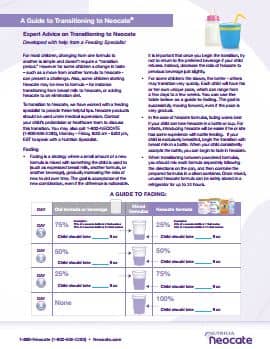 Infancy is a time marked by rapid growth, requiring important nutrition in the form of breast milk and/or infant formula. A doctor may recommend Neocate for your infant due to cow milk or food allergies and related symptoms, or you may need to add Neocate to an elimination diet.
Infancy is a time marked by rapid growth, requiring important nutrition in the form of breast milk and/or infant formula. A doctor may recommend Neocate for your infant due to cow milk or food allergies and related symptoms, or you may need to add Neocate to an elimination diet.
Any transition to a hypoallergenic formula like Neocate can present challenges. Many parents come to us with questions about the taste of formulas like Neocate. Infants, especially older infants, can have trouble changing to a formula with a different taste and consistency to what they’re used to. We can’t provide medical advice, so the first and most important thing to do is to talk to your healthcare team! We’ve got a great resource, below, but here are a few points:
-
Some feeding specialists and pediatricians often recommend sticking with the straight Neocate. This depends on the clinician – it often is just a matter of time for many infants to adjust to new tastes. Like the unfamiliar taste of a new vegetable, it can take up to 15-20 times before they get used to the new taste of formulas like Neocate.
-
We can’t provide recommendations for changing the flavor of Neocate infant formula – manufacturers can’t add flavors or sweeteners to infant formulas. It’s best to discuss with your child’s healthcare team to see if they have recommendations. Some healthcare teams may suggest ways to change the taste of infant formula, but we cannot recommend this.
- Sometimes it’s necessary to supplement breast milk with Neocate infant formula. Many parents see success when mom expresses breast milk, blends it with Neocate mixed according to the healthcare professional’s instructions, and feeds the infant using a bottle. That way the “taste” and feeding method are consistent between feedings. A baby may be more likely to refuse the bottle if she goes back and forth from breast to bottle, especially if the bottle feeds are only Neocate.
Because parents come up with lots of questions for these transition scenarios, we have worked with a Feeding Specialist in developing helpful tips to use in these transition situations. You can find two printable, 2-page documents with helpful tips titled ‘A Guide to Transitioning to Neocate’ and ‘Feeding Tips for a Successful Transition’ on this page of helpful resources.
The key strategy for many transitions is a process called ‘fading.’ Fading involves adding the new formula (Neocate) to the old one in increasing amounts over time. It’s important to talk to your LO’s healthcare team to see if they recommend fading, and if it might work for you. (Sometimes, especially if food allergy symptoms are challenging, they may not want you to keep the old formula in your baby’s diet.)
Here are some of the highlights:
- First, remember that schedules and routines are important when embarking on a transition. Keeping consistent with these will have an impact on your success. Be patient and relax.
- The overall goal is to have your child accept the new combination as they work their way into the overall change. This might require lessening the first amount of Neocate that’s introduced, however; try to avoid returning to 100% of the previous product.
 Transition times will vary between children. Some may readily accept the new combination while others may require more time. The goal is to move forward with success even if the pace is very gradual.
Transition times will vary between children. Some may readily accept the new combination while others may require more time. The goal is to move forward with success even if the pace is very gradual.
- Transitions can impact the digestive system and can be marked by changes in body outputs- stools, gas and spit-up. These might be something new, or changes to existing habits. See our FAQs page and read the ‘What you may see’ entry for more details.
- If changes feel a little too unsettling, talk to your healthcare provider or ask them to refer you to a Feeding Specialist.
Additional tips based on developmental psychology
Research shows that although children are born with predispositions for certain food preferences, the majority of food preferences are shaped by experience1. A child’s food acceptance and preference are strongly influenced by the way their parents present these foods. Children learn to accept and prefer foods which are presented repeatedly and in a positive manner. At the same time, if a food is presented in a negative context, the child is likely to dislike and reject the new food (which is the most likely reason for the baby I described above not wanting the formula).
Therefore, if you present the new formula positively, even tasting it yourself and showing a pleasant response, your child is much more likely to accept and even like it. Likewise, if you display your distaste for the formula in front of your baby (for example making a disgusted face and exclaiming “this formula tastes gross!”), your baby is likely to learn to dislike it as well.
So, the takeaways are:
- When introducing a new formula to your baby, keep a positive and supportive demeanor. Try not to make unpleasant facial expressions or negative comments in front of the baby.
- Remember that children learn to accept foods which are presented repeatedly, so don’t be discouraged if your baby doesn’t accept the new formula right away.
Below are links to further posts from our blog that address transitions.
As always, if you have questions about using Neocate products, please give our Nutrition Services team a call at 1-800-365-7354, Mo-Fr, 8:30am-5:00pm, ET. We can’t give medical advice, but we can answer your questions about using the products!
What tips have you found helpful in your transition?
-Jody L. Benitz, MS, RDN
-Rob McCandlish, RDN
Image from Abigail Batchelder
1. Birch, LL. Development of Food Acceptance Patterns in the First Years of Life. Proc Nutr Soc. 1998 Nov;57(4):617-24.
Last updated November 27, 2018






